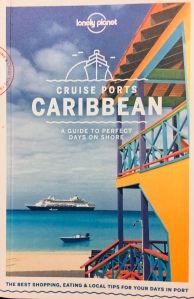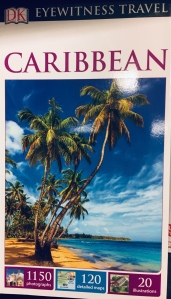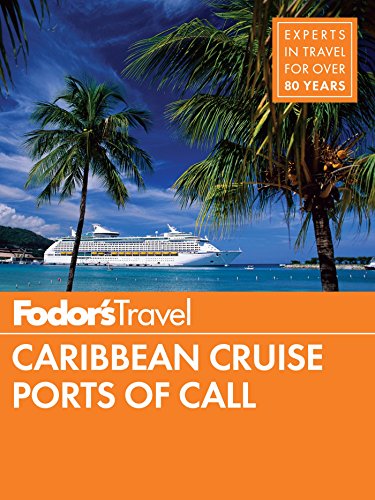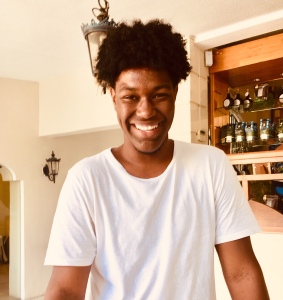
“How phallic!”
I blurted this out on my first Caribbean cruise when Bill and I came upon this huge column rising out of a fountained plaza in Old San Juan, Puerto Rico. It was called the Totem Telurico, and it commemorated the 500th anniversary of Columbus’s discovery of the Americas.
Most of the totem was a reddish brown color with irregular projections that resembled pottery shards. The clay came from all over the Americas, representing the origins of the peoples of the Americas. Shards are about all that’s left of the native island peoples who encountered Columbus and his ilk.
This was my first time to travel by cruise ship. It was a chance to travel with friends. It was a chance to drop a few dollars in post-hurricane Puerto Rico. As it turned out, I got a whole new perspective on the Caribbean as a whole. It is an epic story, spread over thousands of miles and hundred of years, like a real-life Greek tragedy.
When I hear “Caribbean,” I think of the white beaches, turquoise waters, warm weather and relaxation that I enjoyed on earlier visits to the Bahamas and Jamaica. It’s not my favorite kind of vacation. I remember being in the West End of the Bahamas some years back, and after three days of hanging out at the beach, took a moped to Freetown to check out Bahamian culture. But there was no “there” there, just shops. Despite the sights promoted in all these travel books, it felt like that these islands lacked cultural depth.



Being “discovered” by Columbus was catastrophic for the indigenous people, the Taino. In Puerto Rico and the Dominican Republic, the native people were completely wiped out within two generations. Causes include diseases such as smallpox, measles and influenza for which the Indians had no immunity. Outright killing and harsh enslavement also contributed. And it wasn’t just by the Spanish. In 1626, the English and French united to kill the natives on St. Kitts. After the massacre, they resumed their war against each other.
That history of population extinction or near-extinction, the enslavement and importation of African peoples and the loss of cultural identity played out throughout the Caribbean islands irrespective of the nationality of the colonizer—Spanish, British, French, Dutch or Danish.

What remains are archaeological: petroglyphs and pottery, some ruins and a few borrowed Taino words. (Our “hurricane” comes from the native huracán.) What is lost when an entire civilization disappears are their cultural practices, religion, food choices, music, sports and, perhaps most importantly, their founding myths. Even though the institutional memory of Taino is gone, many current inhabitants of these islands still have Taino blood because the all-male European expeditions must have mated, by force or persuasion, with the local women.
***
Since medieval times, sugar was a scarce, luxury item in Europe. Kings flaunted their wealth by serving sugar to their guests. Sugar cane only grew on a few islands on the African coast. The Caribbean climate was ideal for sugar cane. However, the growing, harvesting and processing of the crop required large numbers of workers. Since the small population of surviving natives was unsuited to the harsh conditions in the sugar fields, the Europeans imported slaves from Africa on an unprecedented scale.
Most of what Americans know about African chattel slavery comes from our knowledge of the slavery system in the American South. That system got its start in the 1500s in the Caribbean. If it were not for the sugar plantations that so enriched the colonists and their mother countries, the “peculiar institution” that led to the Civil War might not have happened.

Sugar was unbelievably lucrative. Some have called sugar the opiate of the 17th and 18th century. (Science is still debating whether or not sugar causes neurophysiological changes.) No matter how much sugar was produced, demand matched it. St. Kitts, only 18 miles long and 5 miles wide, had 62 sugar plantations. By the 1780s, Saint-Domingue, modern day Haiti, the size of Hawaii, produced about 40 percent of all the sugar consumed in Europe.
All this productivity – and profit — depended on slave labor. On all these islands, slaves overwhelmingly outnumbered the Europeans. In order to keep them in line, to maximize profit and, because they could, the white owners cruelly abused the slaves. I quote a passage by an educated black man during the time of the Haitian Revolution (1789-1804)
Have they [the French masters] not hung up men with heads downward, drowned them in sacks, crucified them on planks, buried them alive, crushed them in mortars? Have they not forced them to eat excretement (sic)? And, having flayed them with the lash, have they not cast them alive to be devoured by worms, or onto anthills, or lashed them to stakes in the swamp to be devoured by mosquitoes? Have they not thrown them into boiling cauldrons of cane syrup? Have they not put men and women inside barrels studded with spikes and rolled them down mountainsides into the abyss? Have they not consigned these miserable blacks to man-eating dogs until the latter, sated by human flesh, left the mangled victims to be finished off with bayonet and poniard?
Wikipedia
Slave revolts big and small kept popping up. Is there any wonder? The most successful was the Haitian Revolution that led to the first independent black republic in the Western hemisphere in 1804.

It is the descendants of these slaves who I encountered on my trip. I only got to meet them at a very superficial level, another downside of cruising. Still, it struck me as ironic, if not downright perverse, that the sights the tour guides of these countries are showing off tend to be those related to their oppressors. Besides the Totem Telurico, we saw the statue of Ponce de Leon, yes, that Ponce de Leon, who was Puerto Rico’s first governor.
In the Dominican Republic, we toured the Alcazar, home of Christopher Columbus’s son Diego, who served as the “Governor of the Indies.” In St. Kitts, we visited Romney Manor, one of whose owners was Thomas Jefferson’s great, great, great grandfather. Aruba and Curacao had a slightly different history. The climate was too dry for sugar, but being very close to the South American mainland, they became huge slave trading depots.

These islands were more than just moneymaking engines for the European countries. These islands were also the launching pad for the conquest of Central and South America and the looting of an estimated 180 tons of gold and 16,000 tons of silver. Without the ability to amass the men, weapons and horses on the Caribbean islands, the Spanish would not have been able to launch the mainland invasions to defeat Montezuma and the Incas.
Before this trip, I had always thought that these vacation isles were politically irrelevant. I was wrong. The Caribbean islands were always pawns in global politics. In 1494, the Treaty of Tordesillas, brokered by Pope Alexander VI, divided the whole non-European world between Spain and Portugal. In 1636, the Dutch took Aruba and Curacao from the Spanish during the Thirty Years War. Puerto Rico was “won” by the United States in the wake of the Spanish American War (1898).
During World War II, even though the Netherlands was occupied by the Nazis, its colonies Aruba and Curacao were not. As oil refining centers for the vast oil fields of Venezuela and Colombia, these islands supplied oil to American, British and French forces. Much oil was also shipped by tankers to the Russian ports of Archangel and Murmansk to help Stalin fight the Nazis.
I now think of the Caribbean as the crucible that molded the Americas. But the cost was incredibly high to the native peoples and the imported slaves even up to today.
There is a great yearning by the descendants of these people, spread out over 7000 islands, 28 nations and dozens of languages if you include creoles and patois, for stories that explain their situation, their history, their place in this world in an authenic way.
This is a prodigious task for at least two reasons. One is the lack of origin myths and the dislocation of slavery. The other is the great and gorgeous variety of centuries of local development and adaptation. Since the 1950s, academic papers and a rich trove of literature from writers including Nobel Prize winners Derek Walcott and V.S. Naipal have explored the Caribbean landscape and identity. Marlon James, Juno Diaz, Jamaica Kincaid, the musician Bob Marley are just a few of the others.
On these cruises, they show you forts and colonial palaces. They take you to beaches and shops. But, if you pay attention, 500 years of history and culture unfold in all its riot of colors and complexity right in front of you.
Tell me: What surprising things have you learned on your travels?
8 replies on “The Caribbean: Not At All What I Expected”
Thank you, Cathy, for educating me about the Carribean Islands and the history and cultures of native people. When we visit these islands, we will sure pay attention to the sights you shared in this blog.
LikeLike
Thank you for sharing the history of this region.
Regarding travel surprises, I learned some family stories (including some skeletons) when we traveled to Japan with my parents. Years later we took a trip to Japan with our kids to come full circle.
LikeLike
Wow Cathy…an amazingly sad story behind this beautiful space. Will humans ever recover dignity and social justice? Xox mary dee
LikeLike
Cathy,
This is a really interesting perspective, going beyond–as you point out–the stereotypical construct of beaches, bars and shopping. You painted a much more complex picture of the region. Thanks!
LikeLike
So glad it wasn’t up to me to figure out this tech issue! Thanks, Sue.
LikeLike
Well, wierd. When I go to it from the email, I see all the appropriate buttons. Me, bad!
LikeLike
Very interesting. I’m so impressed that you are keeping up such a steady pace.
I was going to share this on my facebook page, from your webpage, since a lot of my contacts seem to go to the Caribbean a lot and the islands are in the news because of hurricanes. But you don’t have a FB button on the page or, as far as I can tell, a way to leave a comment on the page. Although I do see the comment line on this emailed version. Maybe I’m doing something wrong. I’ll try again.
LikeLike
Wow! I knew about the sugar cane plantations, but not so much about slavery or the pivotal role the islands played in world history of the Americas. I’ll never think about the Carribean islands the same way.
LikeLike